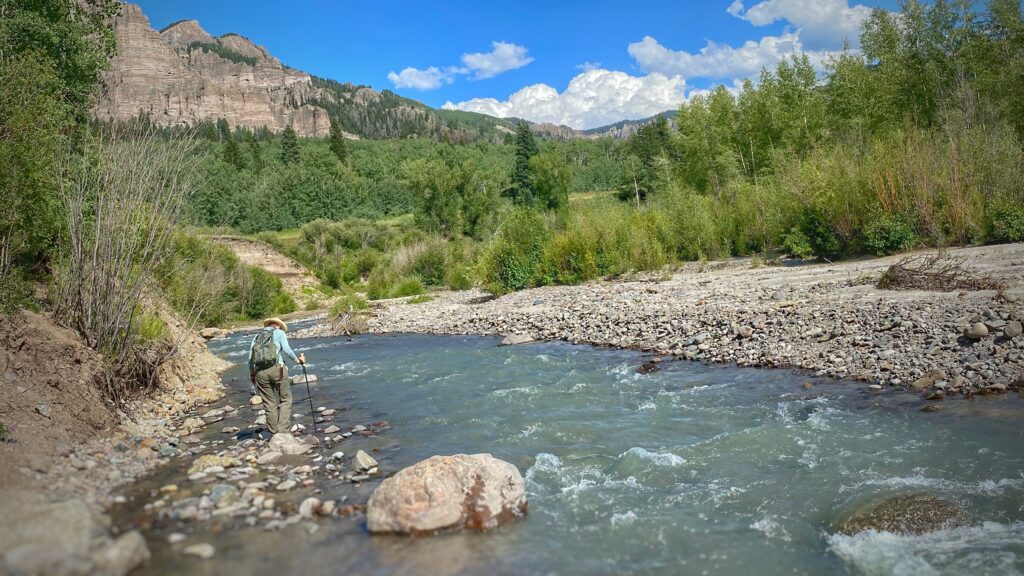
Practicing Presence
As I approach the river, my mind is filled with all of the usual noise. Annoyance about the bill I left unpaid on the counter before I headed out this morning. The three emails waiting in my inbox waiting for a response. The self-judgement about often being terrible at follow through. The big question about what I’m going to do with myself now that traveling the country playing songs is no longer the viable career it once was. Chuckling a bit at the idea that it was ever a truly viable career.
About this time I reach a spot that requires a crossing. It’s mid summer in the high country of Southwestern Colorado and, against better judgment, I’m wet-wading rather than enduring the bulk of waders for a hike in to the backcountry. As I make the first step into flow, mind still an echoing cacophony, the icy stab of water as it soaks quickly through my wading socks demands my attention…all of it. In this moment, there is no more room for the noise, only the singular focus, the shock of cold on hike-heated toes.
This is just one snapshot of albums full of mental polaroids depicting moments where the pursuit of fly fishing has practically slammed me into the present. I believe the path to inner peace is paved with presence. And getting grounded in the moment is a pretty good start. I believe one of the best ways to get grounded is to put your feet in a river. To connect with all that is around you. To notice the beauty, the ruin, and to allow yourself to feel a part of it.
So yeah, being present is a great start, but when I think about many of the times I struggle in life, a lack of patience…with a situation, another person, or even myself is hiding in there somewhere…
Practicing Patience
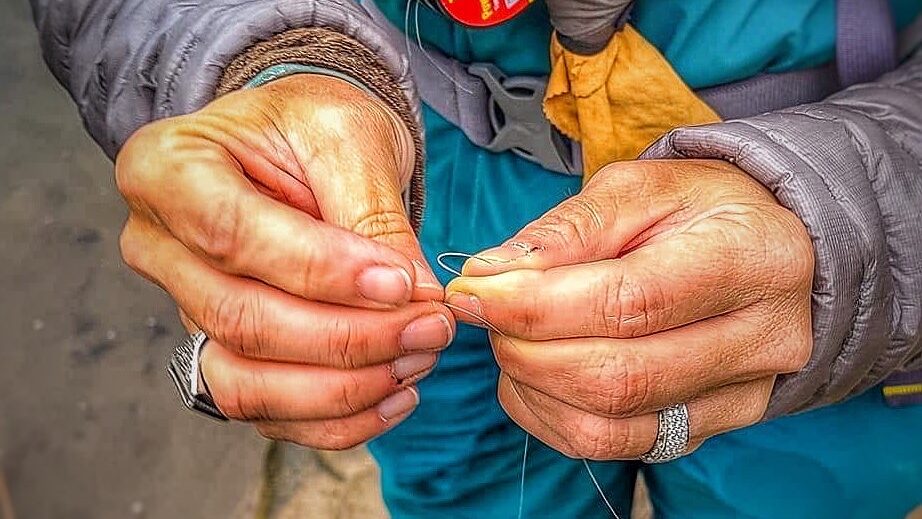
It was the knot-tying portion of one of my beginner workshops. I think it was a loop knot in this case. I demonstrated each step of the knot and waited until everyone else completed it before moving to the next. All but one student was with me, and as she struggled and restarted the step, and the knot, several times, her frustration became palpable.
As I always do, I had told my students that I had pretty much a bottomless pit of patience on their behalf, so it wasn’t me she was worried about. It was her own lack of patience with herself that she was wrestling with…along with likely other internal messages she was making up about being the last to complete it and pondering what everyone must think about her.
“Hey,” I said gently, “Look at me. Now breathe with me. That’s right. We’re not in a hurry here. We’re all sitting under a shade tree next to a crystal clear lake on a beautiful Spring afternoon in Texas with nothing on the agenda but being here. Now, let’s go through that step together. Slowly.” In that very moment I watched her shoulders drop, her eyes soften, and the redness in her cheeks begin to fade.
Practicing Self Control
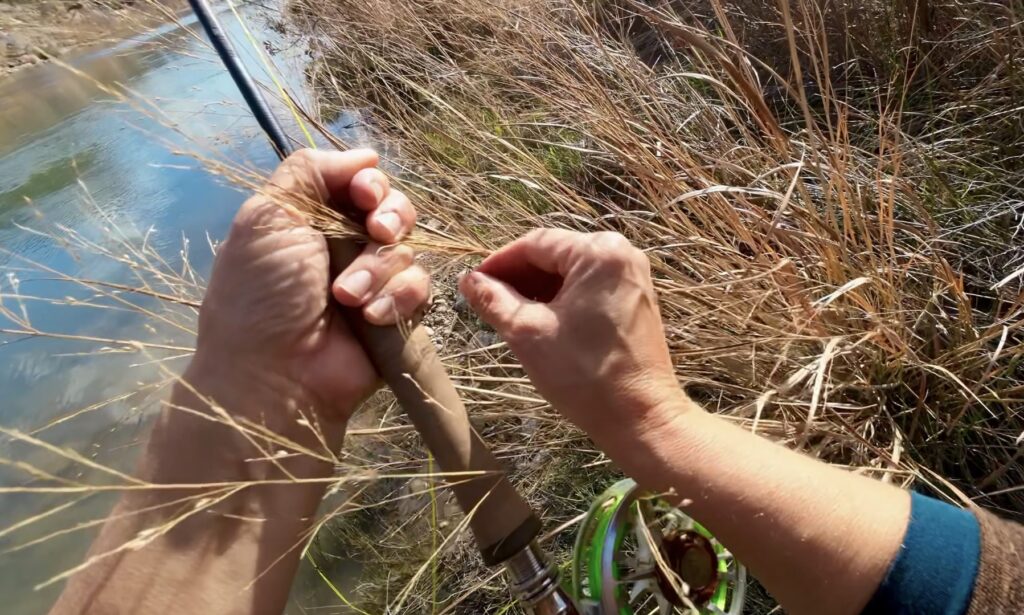
We’ve all been there. Maybe it’s a windy day. Maybe there’s a high bank, or a tree, or brush, or sometimes it’s a single blade of grass. And it seemingly snatches your backcast out of mid air. You look back, and not only are you snagged, your tippet has wrapped and tied itself around that snag no fewer than 800 times. For folks who live in places where the vegetation is “tender,” perhaps a little twitch or tug will free you up. But we don’t live in one of those places, we live in Texas. Things that grow here are tough. A necessary quality if they are to thrive, or at least survive, in the often harsh environment. Which is another metaphor worth pondering…another time.
So you’re quite convincingly tangled. Maybe for the umpteenth time that day. If you want to save your flies and not risk snapping your rod tip, you have no choice but to wade back and/or climb over to the tree-bush-thistle-grass (or, if it’s the Llano, maybe the granite) to take care of business. Once you get there, you have a couple of choices. Option A, you can cut the tippet, pull out the flies, and re-rig. Or, option B, you can attempt to untangle the nest of tippet until you either succeed or resign yourself to the fact that it is beyond saving and circle back to option A. But it’s not really those external choices that hold the most valuable opportunity.
That choice it to turn the entire experience on its head. It’s to decide that this happening is not an interruption of your relaxation, your zen. It’s part of it. The mindless, and meditative, if you’ll let it be, activity of twisting and threading, of weaving in and around until you have freed your flies can do the same for you.
Going with the Flow

I was guiding a couple of folks from Houston for trout on the Guadalupe this season past. They said they wanted to learn how to become better independent fly anglers, and I believe a wade trip is the one of the best ways to do that. So we made the plan and met up bank side. We had just begun to practice the modified roll cast I like to teach clients for indicator fishing. As they practiced the cast and learned to anticipate the mends necessary to manage a good drift, one of them (who was doing quite well, I might mention) was growing frustrated at an apparent lack of perfection and confessed that they were really competitive and often hard on themselves.
“Okay,” I said, “let’s just stop for a second and look around at the beauty that is all around us. Take a deep breath. There’s nothing to worry about here and now. You’re doing better than you think. But either way, if you make this trip all about perfecting fishing techniques and landing fish, you’ll miss out on a lot of what’s available to you. The river can both soothe us and teach us if we’ll let it. In your case, I encourage you to focus on the flow. Just flow with the river today. The rest will come.”
And it did. Both clients landed their personal best rainbow trout that day, but more importantly, they let go of their attachment to results and allowed themselves to be immersed in the moment, to go with the flow. And in choosing that, they were going to have a great day on the river that had nothing to do with counting catches.
Fly Rod as “Mood-ometer”
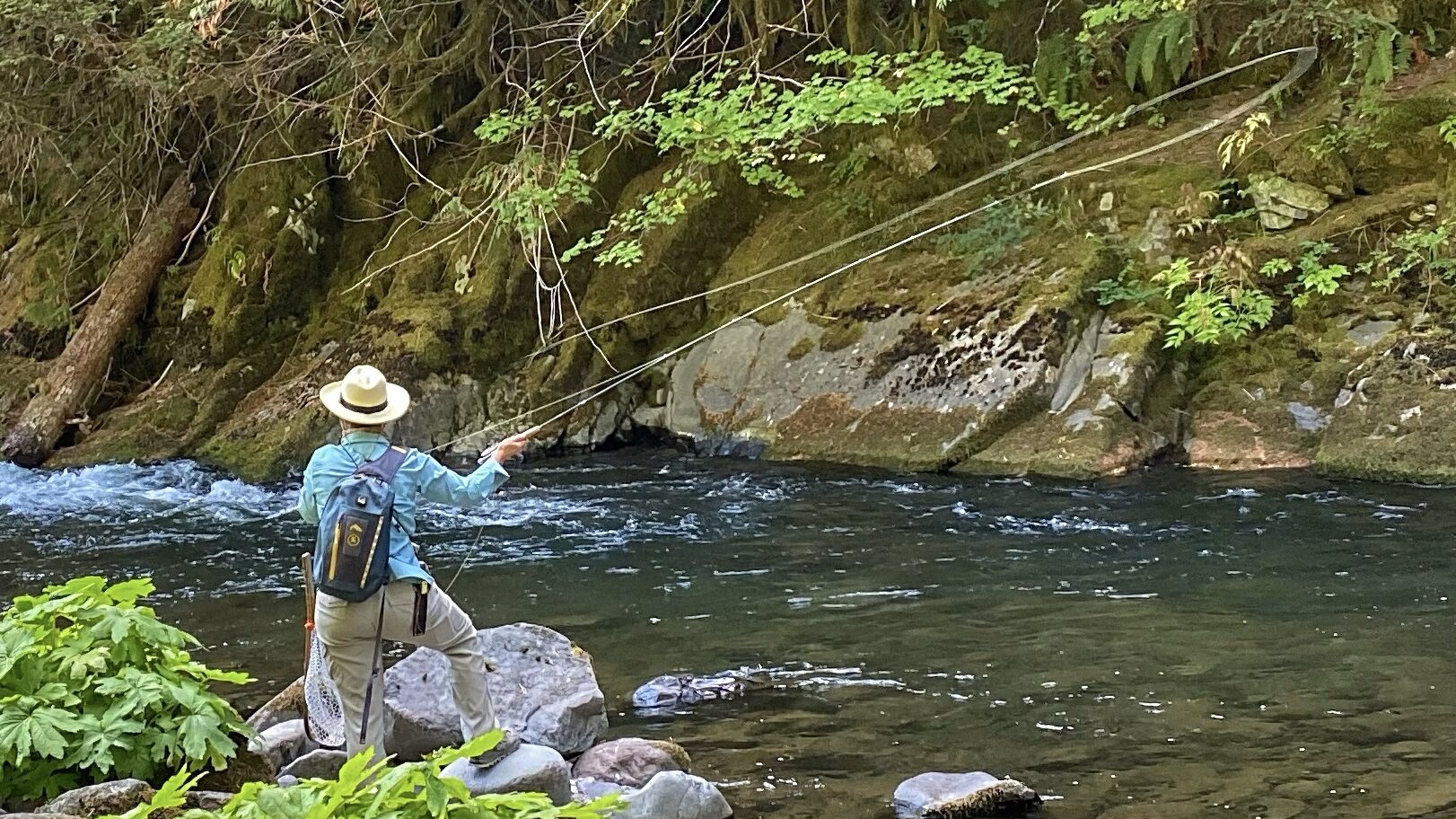
I’ve long said that a fly rod, and more specifically a fly cast, is the best barometer for my state of mind I’ve ever found. I’m a casting instructor, for heaven’s sake, and some days I swear I couldn’t land a fly in a kiddie pool at 10 paces. Among other things, a fly cast is so much about proper timing. When I’m tense, by rhythm goes to pot. My loops get ugly, my flies land ugly. I may even (for shame) throw a “wind knot.” Isn’t it cute how we like to blame our casting mistakes on the wind. Hard to tie knots without opposing thumbs, I say. And in those instances, if I’m not careful, my mood gets pretty ugly, too…which makes my performance even more dismal.
But here’s one of the great things about a fly rod. In addition to being a good measure for your level of tension, if you’ll let it, it’s also a good tool for releasing tension. And that effect is compounded when you put a slower-action rod in your hand…one that commands you to take your time. To wait. To relax.
Job number one in this situation is raising your awareness enough to realize that you, not the fly rod, are both the problem and the solution. Then you have the opportunity to choose. You can stay tense and stressed, or you can choose to use the tools at your disposal to help you find your way to a balanced state of mind.
Finding the Calm in the Cast

The mentally and physically therapeutic aspects of fly casting are well documented at this point. A few of the most well known examples of its application are the retreats and mentoring offered by organizations like Casting for Recovery, Reel Recovery, and Project Healing Waters, to name a few. If you haven’t checked out those organizations, please do so and c onsider supporting them financially or with your time.
Mention those organizations to fellow fly anglers and they’ll probably say something like “yeah, that’s so awesome,” or, “I think it’s great how they help those people.” Well, yes, it is. And if you own, or can borrow, a fly rod, enjoying that very same benefit just a cast away.
The activities associated with fly fishing offer ample balm for body, mind, and soul…wading, fishing, spending time in nature. But they are all, I wager, eclipsed by the moving meditation that is fly casting. The motion, the rhythm, the flow…the fact that when one is focused and connected with the cast, everything else effectively disappears.
You don’t have to wait until you go fishing to tap into that zen. In fact, it would likely help your angling game as well as your mental state if you didn’t wait. Casting, to me, is almost its own pursuit. Even before I was training to become an FFI Certified Casting Instructor, I kept a reel spooled up with some “lawn line.” Not just to practice a particular casting style in preparation for a planned trip, or to work on casting in windy conditions, but as a stress reliever.
And now that so many of us work remotely, it becomes possible to access this support just about any time. Look at it like a modern-day “smoke break,” only without the health risks. If it’s not something you’ve done before, it might feel a little strange at first to stand on the lawn making casts. And if you do it in public, it can take a little time to get used to the occasionally annoying but good natured “Hey there, you’d have better luck if you cast that into the water,” or “Um, you know there’s no fish there, right?!?” But I promise you, it’s totally worth it, and learning to chuckle along with the peanut gallery is its own zen practice.
These are just a few of the myriad ways that fly fishing can be leveraged for mindfulness practice. Some without every leaving your back yard. And that’s not even to mention fly tying, which, for some, is a hobby unto itself! If you’ve never tried fly fishing, or tried it and became frustrated or confused too quickly to continue. A little solid instruction or, better yet, a Zen Fly Fishing Retreat or Workshop can go a long way towards helping you practice presence, model mindfulness, and curate calm.
